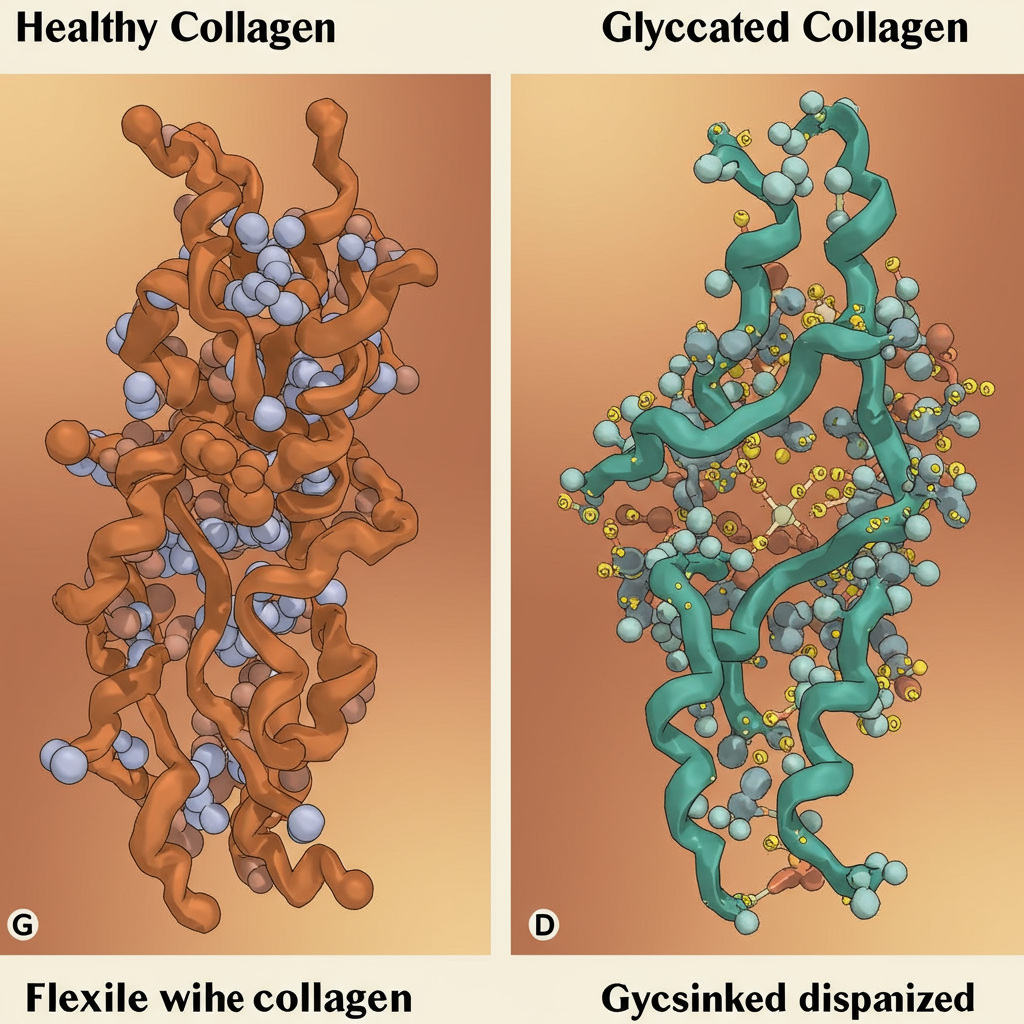In the quest for healthspan extension, we often focus on obvious culprits like blood sugar levels, insulin resistance, and inflammation. Yet lurking beneath these familiar concerns is a more insidious biochemical process that directly accelerates aging: the formation of Advanced Glycation End-Products (AGEs). These complex molecules silently damage our tissues, contributing to everything from wrinkles to cardiovascular disease. Let's explore what AGEs are, how they form, and most importantly—what we can do about them.
The Chemistry of Aging: What Are AGEs?
Advanced Glycation End-Products are exactly what their name suggests—the end result of a non-enzymatic reaction between sugars and proteins or lipids. This process, called glycation, occurs when reducing sugars like glucose chemically attach to proteins or lipids without the help of enzymes. Think of it as a spontaneous caramelization happening inside your body.
Unlike enzymatic reactions that are precisely controlled by your metabolism, glycation is essentially a haphazard process—proteins become "sugar-coated" in an unregulated manner. Once formed, these modified proteins undergo further reactions to become irreversibly crosslinked, forming AGEs. These crosslinks create stiff, dysfunctional proteins that accumulate over time, particularly in long-lived tissues like collagen in your skin, blood vessels, and kidneys.

What makes AGEs particularly problematic is their permanence. Unlike many other metabolic byproducts that your body can break down and eliminate, AGEs form stable compounds that resist degradation. They accumulate with age, creating a measurable "AGE burden" that correlates with many age-related diseases.
The Dark Side: How AGEs Accelerate Aging
The impact of AGEs on health and aging occurs through multiple mechanisms:
Structural damage: AGEs physically alter proteins, especially collagen and elastin, making tissues stiffer and less functional. This contributes directly to skin aging (wrinkles), arterial stiffening, and joint problems.
Receptor activation: Your body has specific receptors for AGEs—aptly named RAGE (Receptor for Advanced Glycation End-products). When AGEs bind to these receptors, they trigger inflammation and oxidative stress, creating a vicious cycle of cellular damage.
Mitochondrial dysfunction: AGEs impair mitochondrial function, reducing cellular energy production and increasing oxidative stress—a double hit to cellular health.
The consequences of these mechanisms manifest in virtually every age-related condition:
- Cardiovascular disease: AGEs contribute to arterial stiffening and atherosclerosis
- Diabetic complications: Kidney disease, neuropathy, and retinopathy are all accelerated by AGE formation
- Neurodegeneration: Both Alzheimer's and Parkinson's diseases show increased AGE accumulation
- Skin aging: Crosslinked collagen from AGEs directly contributes to wrinkle formation and loss of elasticity

For those with diabetes or prediabetes, this process is dramatically accelerated. Higher blood glucose levels mean more raw material for glycation, creating a faster accumulation of AGEs. This explains why people with poorly controlled diabetes often experience "accelerated aging" of multiple organ systems.
The Defense Strategy: Minimizing AGE Damage
The good news is that we can significantly reduce AGE formation and accumulation through targeted interventions:
Glycemic control: The most effective strategy is maintaining tight blood glucose control. Each 1% reduction in HbA1c (a measure of average blood glucose) corresponds to approximately 25% reduction in AGE formation. This is why metrics like glucose variability, time-in-range, and fasting insulin levels are crucial health markers.
Dietary AGE reduction: AGEs don't just form inside us—they're also present in foods, particularly those cooked at high temperatures using dry heat methods. The highest dietary sources include:
- Grilled, broiled, or fried meats
- Processed foods with long shelf lives
- Caramelized or browned foods
Cooking methods matter significantly:
- Boiling, steaming, and poaching produce fewer AGEs
- Using acidic marinades (lemon, vinegar) before cooking reduces AGE formation
- Lower temperature, shorter cooking times, and higher moisture all help
Specific compounds: Several compounds show promise in reducing AGE formation or effects:
- Metformin (a diabetes medication) inhibits glycation reactions
- Alpha-lipoic acid acts as both an antioxidant and glycation inhibitor
- Certain polyphenols like those found in green tea and berries may offer protection
Physical activity: Regular exercise improves glucose disposal and reduces AGE formation, independent of its effects on weight and insulin sensitivity.
The most powerful approach combines all these strategies—maintaining metabolic health through diet, exercise, and targeted supplementation creates a comprehensive defense against AGE-related damage.

Conclusion: The AGE-Less Future
Understanding AGEs gives us a powerful framework for addressing a fundamental aging mechanism. By minimizing glycation through blood sugar control, dietary choices, and strategic interventions, we can significantly slow this aspect of the aging process.
For those already managing diabetes or metabolic dysfunction, controlling AGEs represents a critical but often overlooked aspect of treatment—one that extends far beyond immediate glucose management to address long-term complications and aging itself.
The science of AGEs reinforces a key principle in longevity medicine: the mechanisms of aging aren't inevitable fate but modifiable processes that respond to our choices. By making the right ones, we can age not just longer, but better.
References:
Uribarri J, et al. Advanced glycation end products in foods and a practical guide to their reduction in the diet. J Am Diet Assoc. 2010;110(6):911-916.
Goldin A, et al. Advanced glycation end products: sparking the development of diabetic vascular injury. Circulation. 2006;114(6):597-605.






